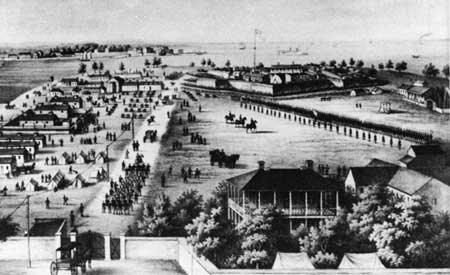|
FORT McHENRY National Monument and Historic Shrine |
 |

Fort McHenry in 1865.
Courtesy Enoch Pratt Library.
Fort McHenry After 1814
In the period after the conclusion of the War of 1812, two factors tended to diminish the military value of Fort McHenry. The development of new and more powerful types of weapons, powder, and projectiles rendered the defense works obsolete, and the rapid postwar expansion of Baltimore's harbor below the fort minimized the strategic importance of Whetstone Point.
Surveys of coast defenses were made in 1818 and 1820, and it was recommended that the War Department abandon Fort McHenry in favor of newer and more strategically located forts. Though newer harbor defenses were constructed, Fort McHenry, which never came under fire again after 1814, continued to make its contributions in every subsequent war.
It served as a regular garrison post until July 20, 1912, when it was finally deactivated. During the Mexican War, Maryland troops were trained there. From 1861 to 1865, Fort McHenry was used as a detention camp for persons under investigation for suspected pro-Southern sentiments and as a prison camp for captured Confederate soldiers. In the Spanish-American War, troops were trained at the fort and embarked from there for foreign service.
In the years that intervened after the fort's magnificent defense of the city of Baltimore, many physical improvements were necessary. For 20 years, facilities were permitted to deteriorate. Then, in 1835, Brigadier General Fenwick reported that not a gun was mounted; the gun carriages and platforms were decayed; and the water batteries were worthless. This gloomy report stirred the War Department to action. Modern weapons and carriages were emplaced on the bastions of the star fort. The barracks were repaired and raised to two full stories. In this period, the present outer battery was started and the old batteries torn down.
During the Civil War, the outer battery was armed with more powerful weapons, some of which are still in their original places. The casemate magazines for this battery were also constructed. In 1873, work was started on a powerful new battery designed to accommodate 25 15-inch guns. Three years later, the War Department suspended this project and it was never completed. By the turn of the century, the absence of modern artillery pieces at the fort made it necessary to transport the garrison to other posts for firing practice.
The city of Baltimore leased the area in 1914 for use as a municipal park. It consisted of 47 acres of land to which the Federal Government had held complete title since 1836. Today there are 43 acres. In 1917, however, the area was restored to the War Department, and a large military hospital was constructed outside the star fort.
In 1925, pursuant to a Federal law, this reservation was dedicated as Fort McHenry National Park and a restoration program was initiated by the Army. All temporary and permanent structures, except the Civil War Magazine in the northwest section of the area, were removed and the old barracks buildings within the star fort altered to correspond to their appearance in the late 1830's.
In 1933, Fort McHenry National Park, which designation was changed in 1939 to national monument and historic shrine, was transferred from the Army to the National Park Service, Department of the Interior, with the unusual stipulation that: "The Secretary of War may, in case of a national emergency, close the said Fort McHenry and use it for any and all military purposes during the period of the emergency." In conformity with this provision, the historic fort performed limited service during World War II when part of the area was assigned temporarily to the Navy and used for a fire-control school.

|

| History | Links to the Past | National Park Service | Search | Contact |
|
Last Modified: Mon, Dec 2 2002 10:00:00 am PDT |

